When I was first dreaming up Practically Deliberate, I brainstormed a list of 20 potential posts.1 Several were related to cultivating a deliberate closet — something I’ve devoted considerable time, energy, and money to over the years.
I’ve now written 27 posts — and studiously avoided this topic.
Why? I imagine it has something to do with what journalist Jonah Weiner observed in his excellent piece about pants in the New York Times Magazine earlier this year: “...we often frame a preoccupation with clothes as vain, frivolous, and otherwise regrettable.” [gift link]
Regrettable or not, Weiner’s piece inspired 738 comments, so people certainly have FEELINGS about clothes (especially pants). I know I do.
So while I don’t want to be dismissed as frivolous, I’ve decided it’s time to go there. Yes, I’m a serious person who loves clothes. Indeed, I contain multitudes.
In this issue (a 10 minute read), you’ll learn:
What I mean by “cultivating a deliberate closet”
How I went from over-buying to closet contentment
My single most impactful deliberate closet move
In another post in this series, I’ll share my deliberate closet “rules.” There’s a poll below to weigh in on other potential topics. And a fun giveaway at the end!
What’s a deliberate closet, anyway?
A deliberate closet (also called an intentional or conscious closet) is what it sounds like: a wardrobe curated with thoughtfulness and consideration. Meaning it:
Aligns with your personal style
Reflects your values and lifestyle
Stays within your budget, and
Minimizes harm to people and planet
This sounds so simple, but each of these requires more education, effort, and energy than we’re typically taught to devote to our closets. Why? Because again, to paraphrase Weiner, clothing is frivolous.
But is it?
The clothes we wear can build — or erode — our confidence. Our clothes are a form of self-expression, a way (as Weiner reminds us), that we “telegraph our taste, cultural affiliations and social status to other people.”
If you care about how you feel and how others perceive you, clothing isn’t frivolous, it’s an important tool in your toolbox — one worthy of attention.
The clothes we wear also impact our wallets and our world. The way we cultivate our closets affects the size and scope of this impact.
Before I go on, let me clarify a few things I do NOT mean by a deliberate closet:
A capsule wardrobe composed of a specific number (or style) of items
Pieces that are considered conventionally “flattering”
A mandate to throw everything out and start from scratch

I feel the need to clarify because in the past, I imagined my closet had to have a certain number of items or look a certain way in order to be considered “deliberate.” I want to make sure no one accidentally takes that away from this post!
I also want to acknowledge that my size has made it easier for me to build a deliberate closet (not to mention get dressed in the first place). Thin privilege exists, and I thank
and , among others, for educating me.How I became a deliberate closet disciple
The simple answer: space constraints. My husband and I share a small closet. My portion is 4 1/2 feet wide; it (plus part of an armoire) is my only available clothing storage space. Every item in my wardrobe must work hard to earn its position.
There’s also a much more nuanced answer...
My mother was a talented sewist and made many of my clothes over the years. From early on, I knew what quality garments looked like and how they should fit.
A value shopper who loved a deal, my mom frequented consignment stores before it was considered cool. She also shunned brand names; the only way she’d buy me the GUESS Jeans I coveted was if we found them secondhand (we never did).
I, on the other hand, cared a great deal about brands. By age eleven, I’d skipped first grade and transferred to new (fancier) schools for fourth and seventh grades. I knew that wearing the “right” clothes helped me fit in.
Once I was making my own money, I no longer had to abide by my mom’s shopping rules. I roamed the malls of Paramus, NJ with friends, spending my hard-earned babysitting dollars in stores like The Limited (RIP) and Aeropostale. When the Gap opened in my suburban town in the early ‘90s, I thought I’d died and gone to heaven.
Some 15 years later, my shopping heritage and career converged when I landed a summer MBA internship at Gap Inc. HQ in San Francisco. Six years later, I parlayed that internship into a full-time role at the company.
Given my penchant for fashion and clothing, at first it was fascinating to work at a global apparel retailer. As a non-profit and public sector veteran, I reveled in the novelty of learning about a new industry and used my employee discount liberally.
But the novelty wore off, and over the next nine years, I grew increasingly disillusioned by the consumerism surrounding me. Not only did my industry and company entice customers to buy new products all the time, the unwritten expectation was that leaders would consistently sport new pieces from our brands. As I climbed the corporate ladder, I found myself wearing my purchases only once or twice before getting rid of them.
This practice was wasteful, misaligned with my values, and ultimately became untenable for me. Later, I learned that if you’re not living in alignment with your values at work, it can lead to something called “misalignment burnout.”2
In an effort to shift away from over-consumption, I developed strict purchasing filters for myself and dramatically scaled back my shopping towards the end of my tenure.3
I still love clothing, but now that I work for myself, I consume it on my own terms. I’ve honed my personal style; identified brands whose values and ethos align with mine; and perfected the art of scoring secondhand pieces at a fraction of what they’d cost new (even with an employee discount).
As a result, I’m more content with my closet than I’ve ever been — while spending less than I have in decades.
In my next deliberate closet post, I’ll share the rules that have been game-changers for me. I’d love to hear what else you’d like to read as part of this series:
My most impactful deliberate closet move
Over the years, I’ve invested more than I care to admit in clothes and clothing-related purchases. I’ve hired several personal stylists; rented clothes; hired a color consultant to identify my “season”; and subscribed to wardrobe styling apps and curated clothing boxes.
Some of those things have been valuable, but none has been as impactful as this: I befriended an expert tailor.
Fifteen years ago, I didn’t realize finding a talented tailor would be so revolutionary.
I had a vision for a beaded shrug I wanted to wear with my wedding dress. At the time, my go-to tailor (my mother) lived across the country, making fittings challenging.
I found a San Francisco-based tailor with rave Yelp reviews, and I brought her a pattern and my fabric of choice. She not only created the wedding shrug of my dreams, she became my friend — and my closet’s secret weapon.4


Why is finding a good tailor such a game-changing move? Because bodies are unique, and mass-produced garments are not. The vast majority of us need help making our clothes fit our bodies better. Even Beyoncé.
For her comprehensive book Worn: A People’s History of Clothing, author Sofi Thanhauser interviewed Shannon O’Hara, “a Brooklyn-based seamstress who tailors Beyoncé’s clothes for concerts, fashion shoots, and red carpet events.”5
Thanhauser quotes O’Hara, who’s been the tailor to many stars, talking about how even the bodies we worship need help getting their clothing to fit:
“I’ve never met anybody who’s perfectly symmetric. Almost everybody has something that’s messed up about them, like one shoulder – one of my shoulders is an inch shorter than the other, and I’m sure yours is, and one of your legs is probably longer, and you definitely have one bigger biceps.”6
Personally, one of my legs is 1/4” longer than the other, and I have a small waist-to-hip ratio. Almost every pair of pants I purchase needs to be tailored.
So many of us, especially women, blame our bodies when things don’t fit, instead of the garments themselves. Finding a good tailor is not only liberating, it expands the set of possible options you can wear. It also ensures your clothes fit well, which increases the likelihood that you wear them and keep them in your rotation longer.
For 15+ years, my tailor has helped me feel good in my clothes, which is no small feat through two pregnancies/postpartum periods, other weight fluctuations, and style evolutions. I’ve brought her numerous items — including secondhand finds7 — that I wanted altered in some way (e.g., excessively puffy sleeves “pruned,” pockets inserted or removed), and she always comes through.
My tailor isn’t accepting new clients, but the good news is that other talented tailors exist. You can look on Yelp or ask a stylish friend — chances are, if someone enjoys clothes, they know a good tailor. Personal stylists often have relationships with tailors, so you can ask for referrals.
Another tip is to build alterations into your clothing budget. Some stores (such as Nordstrom) offer free alterations, but this perk has become harder to take advantage of as stores close. One of the benefits of buying secondhand is that it leaves room in the budget for tailoring.
When I saw my tailor recently, she mentioned she was working on another “Abby shrug.” Apparently my wedding shrug pattern miraculously fits a wide variety of clients, and she’s used it to make at least 15 other shrugs since mine. We joked that it’s the pattern that keeps on giving.
I was delighted to learn I’ve made my tailor’s life easier in this one small way, since she’s improved mine immeasurably.
Abby’s Latest (+ Fun Giveaway!)
On the topic of saving money and our planet: many states and cities charge for single-use plastic bags. Thanks to the clever convertible tote from Notabag, I always have a bag with me, which means I avoid fees while being a “friend of the earth” (as my kids say). I received my first Notabag as a gift, and I loved it so much I bought a few more to keep with me always.
The Notabag folds up compactly (below left) into its own attached pocket. When unfolded, it can be carried either as a tote bag or a backpack (below right).


One lucky paid Practically Deliberate subscriber will win their very own black Notabag like the one pictured above. Paid subscribers can enter to win here or via the button below by 5 pm PT, Sunday, October 27. May the odds be ever in your favor!
Deliberately yours,
Abby
P.S. For more tailor-related content, you must read “ACCOMMODATING” by
, originally published in Talk of the Town and reprinted here.This is the advice I give whenever someone asks me whether they should start a newsletter. If you can’t come up with at least 20 topics you’d be excited to write about, the answer is no.
https://www.forbes.com/sites/traversmark/2024/03/03/a-psychologist-explains-misalignment-burnout-when-your-job-isnt-your-purpose/
The pivot to WFH during Covid made this considerably easier and less noticeable.
Before those of you based in SF ask for my tailor’s contact information, I have to share that she is no longer accepting new clients (don’t hate me). She agreed to appear in my newsletter as long as I didn’t reveal her name or contact information.
Thanhauser, Sofi. Worn: A People's History of Clothing. New York: Pantheon Books, 2022, p. 133.
Ibid, p. 135.
Yes, I’ve fully become my mother’s daughter (I can hear her saying “I told you so” from the great beyond).







Um, this was SO helpful and could not have come at a better time (as I bemoan the fact that I have approximately two pairs of pants for the entire fall/winter season). The tailor suggestion = genius. Please continue to write about this and TEACH US YOUR WAYS!
Not sure if things have changed, but when I lived in France in 2000, I noticed a huge difference in how they dressed vs. Americans. They had a few high-quality pieces that looked great and that they constantly rotated. It was my first introduction to this concept of a deliberate closet and definitely influenced me.